纸箱爆裂强度标准 tappi 810
纸箱爆破力测试标准
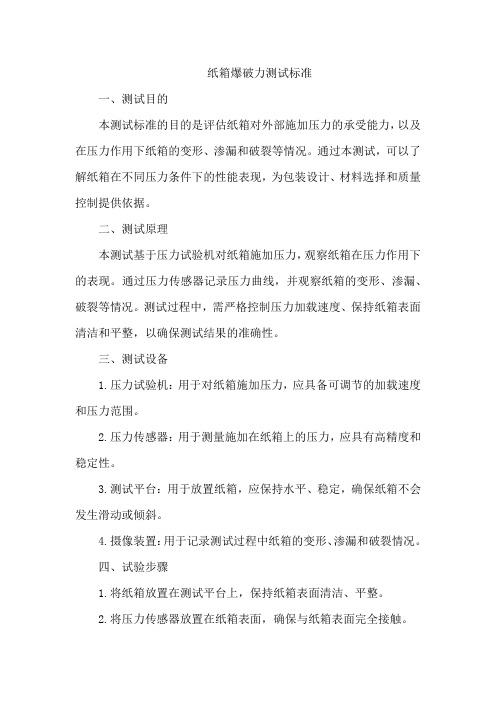
纸箱爆破力测试标准一、测试目的本测试标准的目的是评估纸箱对外部施加压力的承受能力,以及在压力作用下纸箱的变形、渗漏和破裂等情况。
通过本测试,可以了解纸箱在不同压力条件下的性能表现,为包装设计、材料选择和质量控制提供依据。
二、测试原理本测试基于压力试验机对纸箱施加压力,观察纸箱在压力作用下的表现。
通过压力传感器记录压力曲线,并观察纸箱的变形、渗漏、破裂等情况。
测试过程中,需严格控制压力加载速度、保持纸箱表面清洁和平整,以确保测试结果的准确性。
三、测试设备1.压力试验机:用于对纸箱施加压力,应具备可调节的加载速度和压力范围。
2.压力传感器:用于测量施加在纸箱上的压力,应具有高精度和稳定性。
3.测试平台:用于放置纸箱,应保持水平、稳定,确保纸箱不会发生滑动或倾斜。
4.摄像装置:用于记录测试过程中纸箱的变形、渗漏和破裂情况。
四、试验步骤1.将纸箱放置在测试平台上,保持纸箱表面清洁、平整。
2.将压力传感器放置在纸箱表面,确保与纸箱表面完全接触。
3.启动爆破力测试设备,对纸箱施加压力,并记录压力曲线。
加载速度应控制在规定范围内,以确保测试结果的准确性。
4.观察纸箱的变形、渗漏、破裂等情况,记录测试结果。
在测试过程中,应保持摄像装置处于工作状态,以便记录纸箱的实时变化。
五、测试结果分析根据测试结果,对纸箱的爆破力性能进行分析。
比较在不同压力条件下的变形、渗漏和破裂情况,评估纸箱在不同应用场景下的适用性。
同时,可对不同类型、材质和结构的纸箱进行对比分析,以便选择更具有优势的包装材料和设计方案。
六、测试报告1.测试目的:明确本次测试的目的、关注的性能指标等。
2.测试原理:简要介绍测试的方法、原理和依据的标准。
3.测试设备:列出在测试过程中使用的设备和仪器,包括型号、规格和制造商等信息。
4.试验步骤:详细描述试验过程,包括纸箱的准备、压力加载速度控制、摄像装置的使用等。
纸箱抗压试验机测试方法与标准 抗压试验机技术指标

纸箱抗压试验机测试方法与标准抗压试验机技术指标纸箱抗压试验机测试方法与标准_机械/仪表_工程科技_专业资料。
纸箱抗压试验机测试方法与标准纸箱抗压强度测试标准及测试方法纸箱抗压强度测试标准及测试方法,昆山海达仪器为你解答:纸箱抗压强度测试紧要用于各种包装体、纸箱之耐压强度、以防范各种包装体因强度不够导致产品在使用、搬运、堆叠、仓储、运输过程中产品变形、损坏之不良现象发生。
并可做堆码测试,试验的结果可作为工厂堆放成品包装箱高度的紧要参考,而纸箱抗压强度又有以下几点要求: 一、纸箱外观质量: 1、封闭质量:箱体四周无漏洞,各箱盖合拢后无参差和离缝; 2、尺寸公差:箱体内径与设计尺寸公差应保持在大箱5mm,小箱3mm,外形尺寸基本一致; 3、印刷质量:图案、字迹印刷清楚,色度一致,光亮明丽;印刷位置误差大箱不超过7mm,小箱不超过 4mm; 4、盖折叠次数:瓦楞纸箱摇盖经开、合180 度往复折叠 5 次以上,一、二类箱的面层和里层、三类箱里层裂缝长度总和不大于 70mm;此外,要求接合规范,边缘整齐,不叠角,箱面不允许有明显损坏或污迹等. 二、纸箱抗压强度及影响因素:纸箱耐压强度是很多商品包装要求的较为紧要的质量指标,测试时将瓦楞纸箱放在两压板之间,加压至纸箱压溃时的压力,即为纸箱耐压强度,用 KN 表示。
预定纸箱耐压强度纸箱要求有确定的耐压强度,是由于包装商品后在贮运过程中堆码在最低层的纸箱受到上部纸箱的压力,为了不至于压塌,必需具有合适的抗压强度,纸箱的耐压强度用下列公式计算: P=KW(n—1)式中 P————纸箱耐压强度,N W————纸箱装货后重量,N n————堆码层数 K————堆码安全系数堆码层数 n 依据堆码高度 H 与单个纸箱高度 h 求出,n=H/h 堆码安全系数依据货物堆码的层数来确定,国标规定:贮存期小于 30d 取 K=1.6 贮存期 30d—100d 取K=1.65 贮存期大于 100d 取 K=2.0 确定纸箱抗压强度的方法由于受生产过程中各种因素的影响,最后用原材料生产的纸箱抗压强度不愿定与估算结果完全一致,因此最后精准明确确定瓦楞纸箱抗压强度的方法是将纸箱恒温湿处理后用纸箱抗压试验机测试;对于无测试设备的中小型厂,可以在纸箱上面盖一木板,然后在木板上堆放等量的重物,来大致确定纸箱抗压强度是否充分要求;据原材料计算出纸箱抗压预定了纸箱抗压强度以后,应选择合适的纸箱板、瓦楞原纸来生产瓦楞纸箱,避开盲目生产造成的挥霍;依据原纸的环压强度计算出纸箱的抗压强度有很多公式,但较为简练应用的是 kellicutt 公式,它适合于用来估算 0201 型纸箱抗压强度。
包装纸箱质量标准(小编整理)

包装纸箱质量标准(小编整理)第一篇:包装纸箱质量标准包装纸箱质量标准1、双瓦楞(5层)每层每平方克重及纸质要求:第1层(面纸)175G/㎡国产牛皮纸A级第3层(中间夹层)150G/㎡国产牛皮纸A级第5层(里纸)150G/㎡国产牛皮纸A级第2/4层(瓦楞层)100G/㎡高瓦楞2、摔箱测试外箱是否异常(纸箱是否破损或者变形,产品是否破损或变形);视检外箱垂直四条棱边(或面)是否弯曲。
3、堆箱测试采用附件的方法,视检底层外箱是否异常(变形,开裂,产品顶破纸箱,封箱带崩开,产品受损)。
4、打开箱盖翻转270度,往复3次,视检折面开裂小于5CM为合格。
5、瓦愣纸箱含水率12%±4(手感是否潮湿)。
6、唛头文字及图案清晰正确,深浅一致,位置正确。
7、彩盒依据尺寸大小面张每平米克重:60CM见方以下300G;60CM见方以上350G。
彩盒印刷应清晰鲜亮,图案与产品一致。
8、所用胶水为淀粉粘合剂。
9、纸箱不能打钉。
10、纸箱不允许使用打包带。
11、封箱带宽度一般不小于6CM。
12、必要时外箱内应加填充物(隔挡、衬垫、底座等)使产品在外箱各方向受力情况下在箱内处于稳定状态。
13、纸箱在运输、贮存应避免受到雨淋、爆晒、受潮和污染。
附件:纸箱耐压强度纸箱要求有一定的耐压强度,是因为包装商品后在贮运过程中堆码在最低层的纸箱受到上部纸箱的压力,为了不至于压塌,必须具有合适的抗压强度,纸箱的耐压强度用下列公式计算:P=KW(n-1)式中P----纸箱耐压强度W----纸箱装货后重量 n----堆码层数K----堆码安全系数堆码层数n根据堆码高度H与单个纸箱高度h求出,n=H/h 堆码安全系数根据货物堆码的层数来确定,国标规定:贮存期小于30天取K=1.6 贮存期30-100天取K=1.65 贮存期大于100天取K=2.0 具体操作时在纸箱上面盖一木板,然后在木板上堆放等量的重物。
参考资料:GB 5034-85 《出口产品包装用瓦楞纸板》第二篇:Xxx包装纸箱的质量标准Xxx包装纸箱的质量标准 1.目的:建立xxx包装纸箱的质量标准。
纸箱破裂强度试验机操作指导书A0
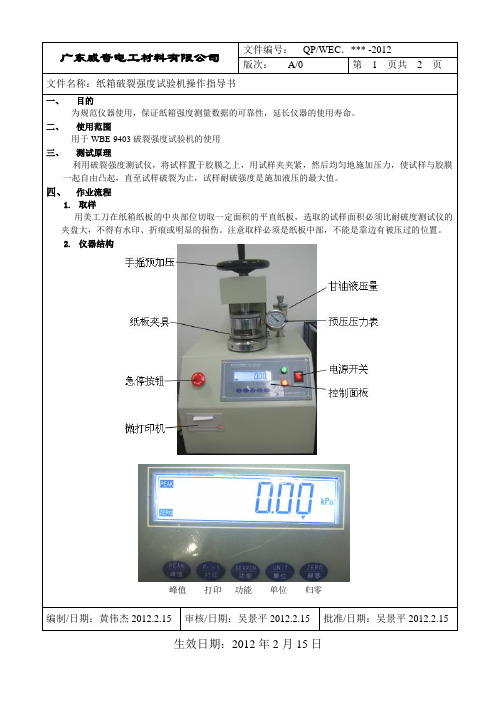
一、 目的 为规范仪器使用,保证纸箱强度测量数据的可靠性,延长仪器的使用寿命。
二、 使用范围 用于 WBE-9403 破裂强度试验机的使用
三、 测试原理 利用破裂强度测试仪,将试样置于胶膜之上,用试样夹夹紧,然后均匀地施加压力,使试样与胶膜
一起自由凸起,直至试样破裂为止,试样耐破强度是施加液压的最大值。
四、 作业流程
1. 取样 用美工刀在纸箱纸板的中央部位切取一定面积的平直纸板,选取的试样面积必须比耐破度测试仪的
夹盘大,不得有水印、折痕或明显的损伤。注意取样必须是纸板中部,不能是靠边有被压过的位置。 2. 仪器结构
峰值 打印 功能 单位 归零
编制/日期:黄伟杰 2012.2.15 审核/日期:吴景平 2012.2.15 批准/日期:吴景平 2012.2.15
生效日期:2012 年 2 月 15 日
广东威奇电工材料有限公司
文件编号: QP/WEC.*** -2012
版次: A/0
第 2 页共 2 页
文件名称:纸箱破裂强度试验机操作指导书
3. 开机 连接220V电源,按下电源开关。注意急停按钮是没有被按下时才可以开机。 检测液压油位置是否够,液压表是否正常。
杯、管路,和及时更换甘油。具体更换方法请参照仪器说明书。 3. 橡皮膜保养。
由于橡皮膜是核心部件,日常不能用有腐蚀性的液体清洗,保证橡胶部位表面光滑干净。 当长期不用,橡皮膜易老化;测试次数过频繁,每天10次以上,持续1~2个月;长期做高压测试时, 橡皮膜都容易破损,需要用厂家仪器附带的标准铝箔片对仪器校准,铝箔片标准破裂强度为11.61± 0.14kgf/cm2,当仪器偏差大于±0.5%时,必须更换橡皮膜。具体更换方法请参照仪器说明书。
4. 单位设置 按“单位”按钮,把液晶屏内的单位调到KPa。
纸箱质量指标
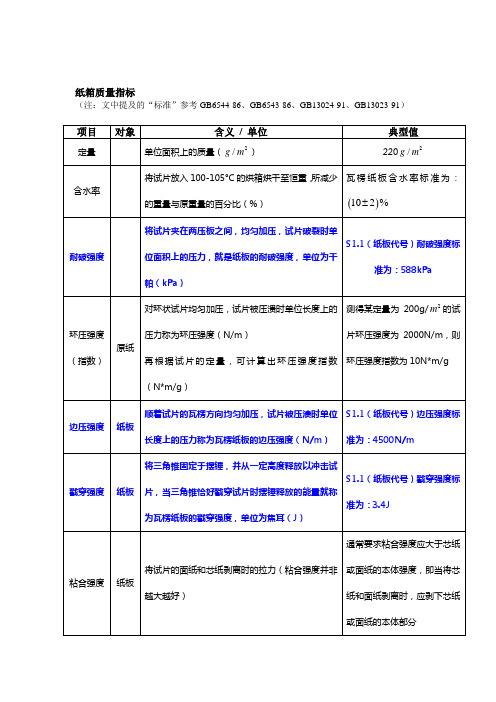
瓦楞纸板含水率标准为:
含水率(10ຫໍສະໝຸດ ± 2 ) %耐破强度将试片夹在两压板之间,均匀加压, 将试片夹在两压板之间,均匀加压,试片破裂时单 在两压板之间 S1.1(纸板代号) S1.1(纸板代号)耐破强度标 位面积上的压力,就是纸板的耐破强度,单位为千 位面积上的压力,就是纸板的耐破强度, 准为: 准为:588kPa kPa) 帕(kPa) 对环状试片均匀加压,试片被压溃时单位长度上的 测得某定量为 200g/ m 2 的试 压力称为环压强度(N/m) 片环压强度为 2000N/m,则环 再根据试片的定量, 可计算出环压强度指数 (N*m/g) 压强度指数为 10N*m/g 顺着试片的瓦楞方向均匀加压,试片被压溃时单位 S1.1(纸板代号)边压强度标 顺着试片的瓦楞方向均匀加压, S1.1(纸板代号) 长度上的压力称为瓦楞纸板的边压强度 N/m) 为瓦楞纸板的边压强度( 准为: 长度上的压力称为瓦楞纸板的边压强度(N/m) 准为:4500N/m 将三角锥固定于摆锤, 将三角锥固定于摆锤,并从一定高度释放以冲击试 S1.1(纸板代号) S1.1(纸板代号)戳穿强度标 片,当三角锥恰好戳穿试片时摆锤释放的能量就称 准为: 准为:3.4J 为瓦楞纸板的戳穿强度,单位为焦耳( 为瓦楞纸板的戳穿强度,单位为焦耳(J) 将试片的面纸和芯纸剥离时的拉力(粘合强度并非 越大越好) 纸箱能承受的最大压力,称为它的抗压强度( 纸箱能承受的最大压力,称为它的抗压强度(N) 验方法:在一定温度(20° 和湿度(65%) 实验方法:在一定温度(20°C)和湿度(65%)下, 压板对纸箱均匀加压,纸箱被压溃时的压力就是该 压板对纸箱均匀加压, 纸箱的抗压强度 通常要求粘合强度应大于芯纸 或面纸的本体强度,即当将芯 纸和面纸剥离时,应剥下芯纸 或面纸的本体部分 纸箱的抗压强度需求应根据 运输环境,运输周期, 运输环境,运输周期,内装物 重量和存储堆码高度而定
纸箱纸板的耐破强度是指以标准规定的方式
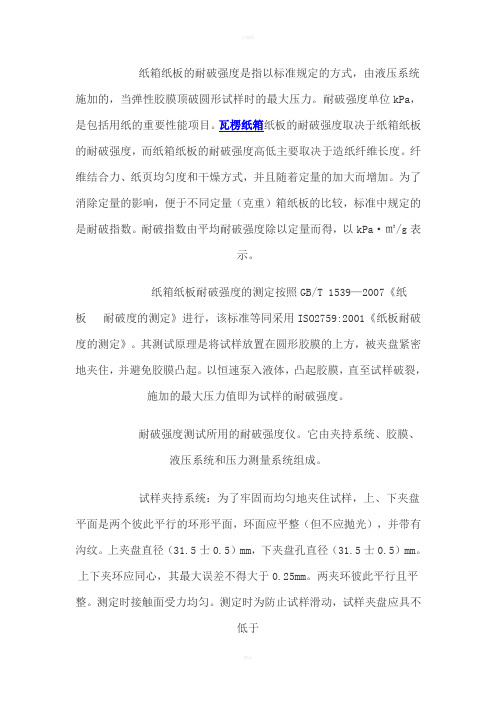
纸箱纸板的耐破强度是指以标准规定的方式,由液压系统施加的,当弹性胶膜顶破圆形试样时的最大压力。
耐破强度单位kPa,是包括用纸的重要性能项目。
瓦楞纸箱纸板的耐破强度取决于纸箱纸板的耐破强度,而纸箱纸板的耐破强度高低主要取决于造纸纤维长度。
纤维结合力、纸页均匀度和干燥方式,并且随着定量的加大而增加。
为了消除定量的影响,便于不同定量(克重)箱纸板的比较,标准中规定的是耐破指数。
耐破指数由平均耐破强度除以定量而得,以kPa·㎡/g表示。
纸箱纸板耐破强度的测定按照GB/T 1539—2007《纸板耐破度的测定》进行,该标准等同采用ISO2759:2001《纸板耐破度的测定》。
其测试原理是将试样放置在圆形胶膜的上方,被夹盘紧密地夹住,并避免胶膜凸起。
以恒速泵入液体,凸起胶膜,直至试样破裂,施加的最大压力值即为试样的耐破强度。
耐破强度测试所用的耐破强度仪。
它由夹持系统、胶膜、液压系统和压力测量系统组成。
试样夹持系统:为了牢固而均匀地夹住试样,上、下夹盘平面是两个彼此平行的环形平面,环面应平整(但不应抛光),并带有沟纹。
上夹盘直径(31.5士0.5)mm,下夹盘孔直径(31.5士0.5)mm。
上下夹环应同心,其最大误差不得大于0.25mm。
两夹环彼此平行且平整。
测定时接触面受力均匀。
测定时为防止试样滑动,试样夹盘应具不低于690kPa的夹持力。
胶膜:胶膜是圆形的,由天然橡胶或合成橡胶制成,不应加填料或添加剂。
胶膜外表面被牢固地夹持着,在非工作状态下,胶膜相对固定胶膜的夹盘外表面约低5.5mm。
胶膜材料和结构应使胶膜凸出下夹盘的高度与弹性助力相适应,即凸出高度:(10士0.2)mm,其阻力范围为170kPa—220kPa;凸出高度:(18士0.2)mm,其阻力范围为250kPa—350kPa。
胶膜在使用时应定期检查,当凸出高度不能满足要求时应及时更换。
液压系统:向胶膜内表面提供持续的液压,直至试样破裂。
纸箱破裂强度试验报告

(Approval)
审核
(Confirmed)
试验者
(Tester)
纸箱破裂强度试验报告(Carton broken intensity test report)
Charge No.﹕
试验日期
(Test date)
No.:
试件
(Trial product)
料号
(Part No.)
NB08934
品名
(Itemname)
纸外箱-1入
315×315×520mm
规格
(Specifications)
样本编号(Sample No.)
测试部位(Test part)
1号箱
(No.1carton)
2号箱
(No.2carton)
3号箱
(No.3carton)
判定标准
(Specification)
正面(Facade)
(Kgf/cm2)
1
14.9
1.边缘压力:3~5Kgf/cm2
(Fringe pressure:3~5Kgf/cห้องสมุดไป่ตู้2)
■研发打样确认(R&D department sample confirm)其它(Others)
试验原理
(Test principle)
用油液压给橡皮膜球力,把纸箱顶破并记录其顶破时力数值.
试验环境
(Test environment)
1.环境温度27℃±2;湿度40%±5%RH.
试验设置
(Test setup)
2.根据该纸箱工程图纸
要求其最小破裂强度为(According to the requirement of engineering design of the carton, the smallest broken intensity is):14Kgf/cm2
纸箱耐破强度测试方法
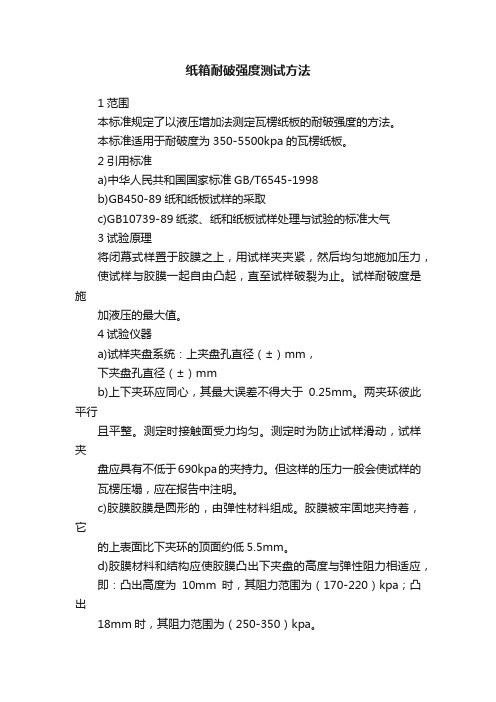
纸箱耐破强度测试方法1范围本标准规定了以液压增加法测定瓦楞纸板的耐破强度的方法。
本标准适用于耐破度为350-5500kpa的瓦楞纸板。
2引用标准a)中华人民共和国国家标准GB/T6545-1998b)GB450-89纸和纸板试样的采取c)GB10739-89纸浆、纸和纸板试样处理与试验的标准大气3试验原理将闭幕式样置于胶膜之上,用试样夹夹紧,然后均匀地施加压力,使试样与胶膜一起自由凸起,直至试样破裂为止。
试样耐破度是施加液压的最大值。
4试验仪器a)试样夹盘系统:上夹盘孔直径(±)mm,下夹盘孔直径(±)mmb)上下夹环应同心,其最大误差不得大于0.25mm。
两夹环彼此平行且平整。
测定时接触面受力均匀。
测定时为防止试样滑动,试样夹盘应具有不低于690kpa的夹持力。
但这样的压力一般会使试样的瓦楞压塌,应在报告中注明。
c)胶膜胶膜是圆形的,由弹性材料组成。
胶膜被牢固地夹持着,它的上表面比下夹环的顶面约低5.5mm。
d)胶膜材料和结构应使胶膜凸出下夹盘的高度与弹性阻力相适应,即:凸出高度为10mm时,其阻力范围为(170-220)kpa;凸出18mm时,其阻力范围为(250-350)kpa。
5试样的采取和处理a)试样的采取按GB450的规定进行。
b)试样应按GB10739的规定进行温湿处理。
c)试样面积必须比耐破度测定仪的夹盘大,试样不得有水印、挤痕或明显的损伤,在试验中不得使用曾被夹盘压过的试样。
6测试步骤a)在条规定的大气条件下进行载样和试验。
b)开启试样的夹盘,将试样夹紧在两试样夹盘的中间,然后开动测定仪,以(170±15)ml/min的速度逐渐增加压力。
c)在试样爆破时,读取压力表上指示的数值。
然后松开夹盘,使读数指针退回到开始位置。
当试样有明显滑动时应将数据舍弃7结果表示以正反面各10个贴向胶膜的试样进行测定,以所有测定值的算术平均值(kpa)表示。
8试验报告a)最终测试结果合格/不合格;b)接下去如果操作改进如果是不合格;c)本国家标准的编号d)样品种类、规格;e)试验所用的标准;f)试验场所的大气条件;g)所用试验仪的型号和加压速度;h)试验结果的算术平均值;其他有助于说明试验结果的资料。
纸板耐破强度检测方法

纸板耐破强度检测方法我折腾了好久纸板耐破强度检测方法,总算找到点门道。
说实话,最开始我就像没头苍蝇一样瞎摸索。
我想既然是检测耐破强度,那肯定得给纸板来点压力,看它啥时候破呗。
我一开始就随手找了个有点重量的东西,想着往纸板上放,看能承受多少就大概知道耐破强度了,这想法简直太幼稚了。
后来,我知道有专门的耐破强度试验机,可我没有啊,这咋办呢?我又尝试用打气筒给一个小气囊打气,然后把气囊抵在纸板下,慢慢增加压力,看纸板啥时候被顶破。
但是这个方法特别不精确,因为很难控制每次打气的量是一样的,而且气囊的受力面积还不好确定,就导致每次测出来的数据乱七八糟的。
又试了几次失败后,我打听了一下有仪器检测时的一些基本原理。
我心想,能不能模拟一下呢。
我就找了个比较平的板子,在上面均匀地堆东西。
这里有个关键啊,东西得均匀地堆,就像搭积木似的,一块一块规规矩矩放,不然受力不均,肯定测量不准。
我慢慢往上加东西,还做记录。
可是我发现我这样手动操作,误差还是很大,因为我每次放东西的速度不一样,对纸板的冲击力可能就有变化。
悔得我呀,早知道最初就该了解清楚,这瞎折腾一圈浪费了好多时间。
直到后来我去请教了懂行的朋友,人家说真正专业的检测,那试验机对于压力增加是有严格规范的,而且对于纸板的固定方式也有讲究。
比如说,纸板要准确对中在测试头下面,就像你投篮一定要对准篮筐中心一样,稍微偏一点,那测量出来的值就不行。
我这才恍然大悟,检测纸板耐破强度可不是简单用东西压一压就行的。
如果要真正准确地检测,还是得有专业的设备,按照严格的操作规程来。
不过要是实在没设备,简单估算的话,像我那样用东西堆的时候,一定要尽可能控制各个影响因素,像东西堆放速度要尽量一致,要让重量均匀分布之类的,但这数据肯定没有用仪器准确就是了。
还有一个我不确定的地方,就是不同材质的纸板可能有不同的最佳检测状态,这个我还只是有点模糊的想法,还需要再查查资料或者做更多实验才能搞清楚呢。
常用纸箱ECT对应的边压和耐破强度表以及计算方法
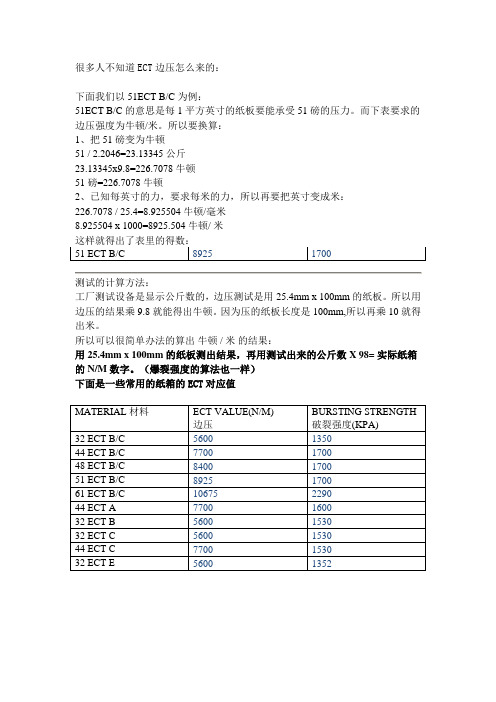
很多人不知道ECT边压怎么来的:下面我们以51ECT B/C为例:51ECT B/C 的意思是每1平方英寸的纸板要能承受51磅的压力。
而下表要求的边压强度为牛顿/米。
所以要换算:1、把51磅变为牛顿51 / 2.2046=23.13345公斤23.13345x9.8=226.7078牛顿51磅=226.7078牛顿2、已知每英寸的力,要求每米的力,所以再要把英寸变成米:226.7078 / 25.4=8.925504 牛顿/毫米8.925504 x 1000=8925.504 牛顿/ 米这样就得出了表里的得数:51 ECT B/C89251700测试的计算方法:工厂测试设备是显示公斤数的,边压测试是用25.4mm x 100mm的纸板。
所以用边压的结果乘9.8就能得出牛顿。
因为压的纸板长度是100mm,所以再乘10就得出米。
所以可以很简单办法的算出牛顿 / 米的结果:用25.4mm x 100mm的纸板测出结果,再用测试出来的公斤数 X 98= 实际纸箱的N/M数字。
(爆裂强度的算法也一样)下面是一些常用的纸箱的ECT对应值MATERIAL材料ECT VALUE(N/M)边压BURSTING STRENGTH 破裂强度(KPA)32 ECT B/C56001350 44 ECT B/C77001700 48 ECT B/C84001700 51 ECT B/C89251700 61 ECT B/C106752290 44 ECT A77001600 32 ECT B56001530 32 ECT C56001530 44 ECT C77001530 32 ECT E56001352常用抢救药物的计算方法和剂量表血管活性药物是临床科室最常用的药物之一。
这些药物是否应用得当,直接影响到病人治疗效果以及病情的转归。
一般静脉点滴法难以保证用药量的准确、恒定。
用药量不够达不到治疗目的,用药剂量过大而造成严重后果,不能使治疗量化,无法准确判定病人对于心血管活性药物的反应如何,不能得到满意的治疗效果。
箱板纸强度标准
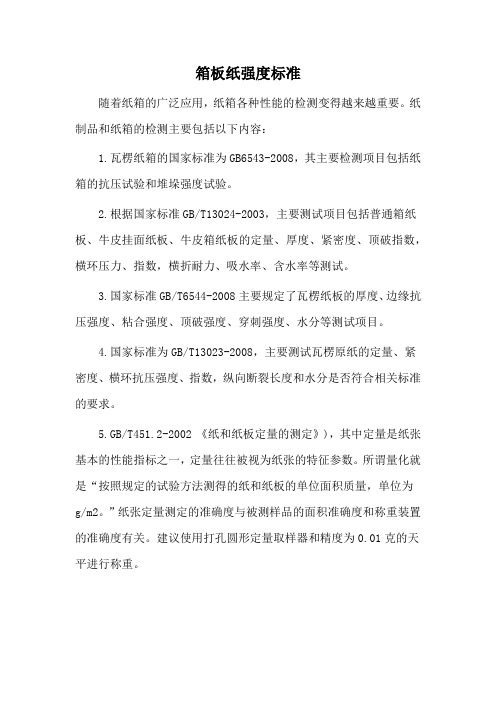
箱板纸强度标准
随着纸箱的广泛应用,纸箱各种性能的检测变得越来越重要。
纸制品和纸箱的检测主要包括以下内容:
1.瓦楞纸箱的国家标准为GB6543-2008,其主要检测项目包括纸箱的抗压试验和堆垛强度试验。
2.根据国家标准GB/T13024-2003,主要测试项目包括普通箱纸板、牛皮挂面纸板、牛皮箱纸板的定量、厚度、紧密度、顶破指数,横环压力、指数,横折耐力、吸水率、含水率等测试。
3.国家标准GB/T6544-2008主要规定了瓦楞纸板的厚度、边缘抗压强度、粘合强度、顶破强度、穿刺强度、水分等测试项目。
4.国家标准为GB/T13023-2008,主要测试瓦楞原纸的定量、紧密度、横环抗压强度、指数,纵向断裂长度和水分是否符合相关标准的要求。
5.GB/T451.2-2002 《纸和纸板定量的测定》),其中定量是纸张基本的性能指标之一,定量往往被视为纸张的特征参数。
所谓量化就是“按照规定的试验方法测得的纸和纸板的单位面积质量,单位为
g/m2。
”纸张定量测定的准确度与被测样品的面积准确度和称重装置的准确度有关。
建议使用打孔圆形定量取样器和精度为0.01克的天平进行称重。
TAPPI瓦楞原纸和纸板测试标准
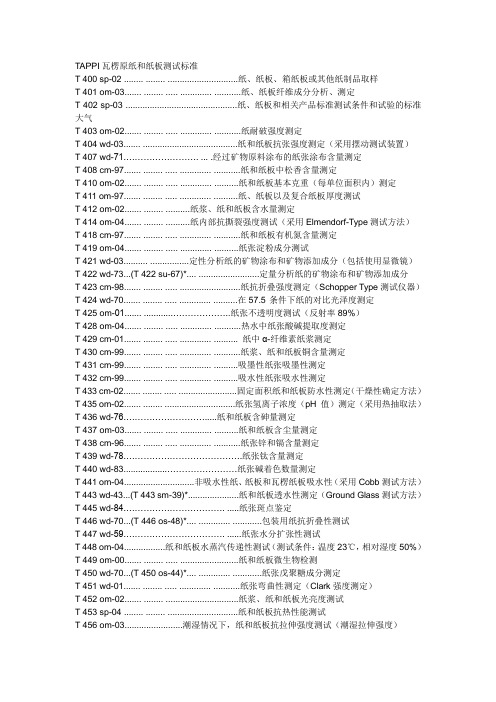
TAPPI瓦楞原纸和纸板测试标准T 400 sp-02 ........ ........ .............................纸、纸板、箱纸板或其他纸制品取样T 401 om-03....... ........ ..... ............. ...........纸、纸板纤维成分分析、测定T 402 sp-03 ..............................................纸、纸板和相关产品标准测试条件和试验的标准大气T 403 om-02....... ........ ..... ............. ...........纸耐破强度测定T 404 wd-03....... .......................................纸和纸板抗张强度测定(采用摆动测试装置)T 407 wd-71.……………………. ... .经过矿物原料涂布的纸张涂布含量测定T 408 cm-97....... ........ ..... ............. ...........纸和纸板中松香含量测定T 410 om-02....... ........ ..... ............. ..........纸和纸板基本克重(每单位面积内)测定T 411 om-97....... ........ ..... ............. ..........纸、纸板以及复合纸板厚度测试T 412 om-02....... ........ ..........纸浆、纸和纸板含水量测定T 414 om-04....... ........ ..........纸内部抗撕裂强度测试(采用Elmendorf-Type测试方法)T 418 cm-97....... ........ ..... ............. ...........纸和纸板有机氮含量测定T 419 om-04....... ........ ..... ............. ..........纸张淀粉成分测试T 421 wd-03.......... ................定性分析纸的矿物涂布和矿物添加成分(包括使用显微镜)T 422 wd-73...(T 422 su-67)*.... .........................定量分析纸的矿物涂布和矿物添加成分T 423 cm-98....... ........ ..... .........................纸抗折叠强度测定(Schopper Type测试仪器)T 424 wd-70....... ........ ..... ............. ..........在57.5°条件下纸的对比光泽度测定T 425 om-01....... ............………………..纸张不透明度测试(反射率89%)T 428 om-04....... ........ ..... ............. ...........热水中纸张酸碱提取度测定T 429 cm-01....... ........ ..... ............. .......... 纸中α-纤维素纸浆测定T 430 cm-99....... ........ ..... ............. ...........纸浆、纸和纸板铜含量测定T 431 cm-99....... ........ ..... ............. ..........吸墨性纸张吸墨性测定T 432 cm-99....... ........ ..... ............. ..........吸水性纸张吸水性测定T 433 cm-02....... ........ ..... ........................固定面积纸和纸板防水性测定(干燥性确定方法)T 435 om-02....... ........ .............................纸张氢离子浓度(pH 值)测定(采用热抽取法)T 436 wd-76.……………………….....纸和纸板含砷量测定T 437 om-03....... ........ ..... ............. ..........纸和纸板含尘量测定T 438 cm-96....... ........ ..... ............. ...........纸张锌和镉含量测定T 439 wd-78.………………………………….纸张钛含量测定T 440 wd-83..................……………………纸张碱着色数量测定T 441 om-04.............................非吸水性纸、纸板和瓦楞纸板吸水性(采用Cobb测试方法)T 443 wd-43...(T 443 sm-39)*.....................纸和纸板透水性测定(Ground Glass测试方法)T 445 wd-84.……………………………. .....纸张斑点鉴定T 446 wd-70...(T 446 os-48)*.... ............. ............包装用纸抗折叠性测试T 447 wd-59.……………………………. ......纸张水分扩张性测试T 448 om-04.................纸和纸板水蒸汽传递性测试(测试条件:温度23℃,相对湿度50%)T 449 om-00....... ........ ..... ........................纸和纸板微生物检测T 450 wd-70...(T 450 os-44)*.... ............. ............纸张戊聚糖成分测定T 451 wd-01....... ........ ..... ............. ...........纸张弯曲性测定(Clark强度测定)T 452 om-02....... ........ ..............................纸浆、纸和纸板光亮度测试T 453 sp-04 ........ ........ .............................纸和纸板抗热性能测试T 456 om-03........................潮湿情况下,纸和纸板抗拉伸强度测试(潮湿拉伸强度)T 457 wd-76.………………………............纸和纸板拉伸强度测试T 458 cm-04....... ........ ..... .........................纸张表面含水能力测试T 459 om-03....... ........ ..... ............. ...........纸张表面强度测试(蜡粘测试)T 460 om-02....... ........ ..... ............. ...........纸张透气度测试(Gurley方法)T 461 cm-00....... ........ ..... ............. ...........经过处理的纸和纸板抗燃性测试T 462 om-01....... ........ ..... ............. ....纸张渗油性测试T 464 om-01....... ........ .......................高温、高湿度条件下,纸和纸板水蒸汽传递性能测试T 467 wd-72...(T 467 m-48)* .... .................. .......纸张石蜡吸收性测试T 468 wd-76.…………………………....纸和纸板水溶性硫酸盐和氯化物测定T 470 wd-96...(T 470 om-89)* .. ........纸张抗边撕裂强度测试(Edge-Tear Stirrup测试方法)T 472 wd-76.………………………. ..... ..纸板环压强度测试T 473 wd-71...(T 473 su-63)*.... ............. .... .......包装材料抗微生物性测试T 474 wd-70.………………………...........纸板弯曲强度测试T 476 om-01....... ........ ..... ............. ...........纸和纸板耐磨强度测试(T aber-Type测试方法)T 478 wd-69...(T 478 sm-60)*... .............. ... ........纸张油墨擦拭性能测试TAPPI瓦楞纸箱测试T 800 cm-96....... .........................................滚筒测试(测试用具:六角滚筒)T 801 om-02....... ........ ..... ............. ............抗撞击性能测试T 802 om-99....... ........ ..... .........................抗跌性能测试T 803 om-99....... ........ ..... ............. ............箱纸板戳穿强度测试T 804 om-02....... ........ ..... ............. ............纸箱环压强度测试T 805 wd-94...... (T 805 om-89)* .. ........................纸箱防水性能测试(采用喷射方法测试)T 806 wd-70...... (T 806 su-46)*.... .............. ........纸箱粘合强度测试T 807 om-03....... ........ ..... ............. ............纸板和挂面纸板耐破强度测试T 808 om-01....... ........ ..... ..........................瓦楞纸板平压强度测试T 809 om-99....... ........ ..... ..........................瓦楞芯纸平压强度测试(CMT测试)T 810 om-98....... ........ ..... ............. ............瓦楞纸板和实芯纸板环压强度测试T 811 om-02....... .........................................瓦楞纸板边压强度测试T 812 om-03....... ........ ..... ..........................实芯纸板和瓦楞纸板层分离性测试T 813 om-04....... .........................................运输用纸箱连接拉伸强度测试T 814 wd-83.....………………................温度升高情况下热融胶剥离性测试T 815 om-01...纸箱和纸箱生产材料(包括运输用纸袋、瓦楞纸箱、实芯纸箱)静摩擦系数T 817 wd-96....... (T 817 om-89)* .. .......................运输用纸箱抗震性能测试T 818 cm-97....... ........ ..... ............. ............纸板环压力测试T 819 cm-95....... ........ ..... ............. ............瓦楞芯纸吸水性测试T 820 cm-00....... ........ ..... ............. ............瓦楞纸板弯曲性测试。
纸箱类检测讲解

瓦楞/蜂窝纸箱类检测包装箱作为现代物流不可缺少的一部分,承担着容装、保护产品的重要责任,包装箱的物理性能指标则成为其质量评估的依据。
稳定的工作环境条件保障了测试数据的准确性和可靠性,并有多年从事纸箱测试专业的资深工程师,对包装箱进行测试分析,为包装箱供应商和包装箱用户提供公正、科学的测试数据。
纸和纸板类检测造纸、纸板、印刷业对于原纸的性能指标要求越来越多,TTS实验室拥有独立25平方米恒温恒湿试验房(保持温度23℃,湿度50%RH),为材料测试提供了稳定的工作环境,提供全部的检测项目,按GB、HG、ASTM、ISO、JIS、TAPPI等标准,分析原纸的性能指标,为您的生托盘/木箱/周转箱类检测托盘及木箱在物流作业及集合包装中承担着重要角色,也是当今社会生产不可缺少的一部分。
性护角/胶粘带检测护角看似简单,但质量控制及工艺流程也都有不同,强度高、缓冲良好是护角使用的基础,性能卓越的护角是现代物流必备的附助器具。
胶粘带在包装中用途广泛,粘力强,不易开裂以及拥有高强的抗拉力,使胶粘带得到应用缓冲材料检测运输包装件测试1.GB/T 4857.1-1992包装运输包装件试验时各部位的标示方法2.GB/T 4857.2-2005包装运输包装件基本试验第2部分:温湿度调节处理3.GB/T 4857.3-1992包装运输包装件静载荷堆码试验方法4.GB/T 4857.4-1992包装运输包装件压力试验方法5.GB/T 4857.5-1992包装运输包装件跌落试验方法6.GB/T 4857.6-1992包装运输包装件滚动试验方法7.GB/T 4857.7-2005包装运输包装件正弦定额振动试验方法8.GB/T 4857.8-1992包装运输包装件六角滚筒试验方法9.GB/T 4857.9-1992包装运输包装件喷淋试验方法10.GB/T 4857.10-2005包装运输包装件正弦变频振动试验方法11.GB/T 4857.11-2005包装运输包装件水平冲击试验方法12.GB/T 4857.12-1992包装运输包装件浸水试验方法13.GB/T 4857.13-2005包装运输包装件低气压试验方法14.GB/T 4857.14-1999运输包装件基本试验倾翻试验方法15.GB/T 4857.15-1999运输包装件基本试验可控制水平冲击试验方法16.GB/T 4857.16-1990运输包装件基本试验采用压力试验机的堆码试验方法17.GB/T 4857.17-1992包装运输包装件编制性能试验大纲的一般原理18.GB/T 4857.18-1992包装运输包装件编制性能试验大纲的定量数据19.GB/T 4857.19-1992包装运输包装件流通试验信息记录20.GB/T 4857.20-1992包装运输包装件碰撞试验方法21.GB/T 4857.21-1995包装运输包装件防霉试验方法22.GB/T 4857.22-1998包装运输包装件单元货物稳定性试验方法23.GB/T 4857.23-2003包装运输包装件随机振动试验方法24.GB/T 2423.1-2001电工电子产品环境试验第2部分: 试验方法试验A: 低温25.GB/T 2423.2-2001电工电子产品环境试验第2部分: 试验方法试验B: 高温26.GB/T 2423.3-2006电工电子产品环境试验第2部分试验方法试验Cab:恒定湿热试验27.GB/T 2423.4电工电子产品环境试验交变湿热28.GB/T 2423.5电工电子产品环境试验冲击29.GB/T 2423.6电工电子产品环境试验碰撞30.GB/T 2423.7电工电子产品环境试验倾翻31.GB/T 2423.8-1995电工电子产品环境试验第2部分: 试验方法试验Ed:自由跌落32.GB/T 2423.9电工电子产品环境试验设备用恒定湿热试验法33.GB/T 2423.10电工电子产品环境试验正弦34.GB/T 2423.14电工电子产品环境试验低再现随机35.GB/T 2423.15电工电子产品环境试验稳态加速36.GB/T 2423.17-1993电工电子产品基本环境试验规程试验Ka: 盐雾试验方法37.GB/T 2423.18电工电子产品环境试验盐雾交变38.GB/T 2423.21电工电子产品环境试验低气压39.GB/T 2423.22-2002电工电子产品环境试验第2部分:试验方法试验N:温度变化40.GB/T 2423.25电工电子产品环境试验低温低气压41.GB/T 2423.26电工电子产品环境试验高温低气压42.GB/T 2423.27电工电子产品环境试验低温低气压湿热43.GB/T 2423.30电工电子产品环境试验浸渍44.GB/T 2423.31电工电子产品环境试验倾斜摇摆45.GB/T 2423.34-2005电工电子产品环境试验第2部分:试验方法试验Z/AD:温度/湿度组合循环试验46.GB/T 2423.35电工电子产品环境试验低温正弦47.GB/T 2423.36电工电子产品环境试验高温正弦48.GB/T 2423.42电工电子产品环境试验低气压正弦49.GB/T 2423.49电工电子产品环境试验正弦拍频振动50.GB/T 2423.50电工电子产品环境试验恒定湿热高加速51.GB/T 19269[1].3-2003 公路运输危险货物包装检验安全规范使用鉴定52.GB/T1448-2005压缩53.GB/T1451-2005冲击54.GB/T2423-10-1995电子电工正弦55.GB/T 5398-1999大型运输包装件试验方法56.GB/T 15172-1994运输包装件抽样检验57.GB/T191-2000包装储运图示标志ISTA国际运输安全测试国际安全运输协会(ISTA)是一个由专业人员和机构组成的协会,是国际包装运输的权威组织。
纸箱爆裂强度标准 tappi 810
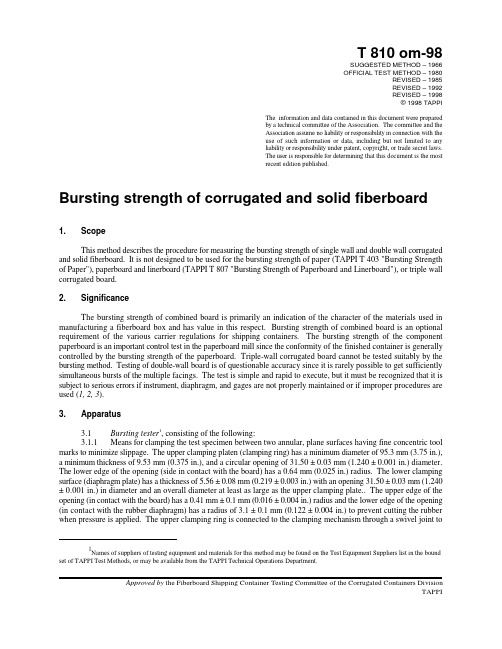
Names of suppliers of testing equipment and materials for this method may be found on the Test Equipment Suppliers list in the bound 1set of TAPPI Test Methods, or may be available from the TAPPI Technical Operations Department.Approved by the Fiberboard Shipping Container Testing Committee of the Corrugated Containers DivisionTAPPIT 810 om-98SUGGESTED METHOD – 1966OFFICIAL TEST METHOD – 1980REVISED – 1985REVISED – 1992REVISED – 1998© 1998 TAPPIThe information and data contained in this document were preparedby a technical committee of the Association. The committee and theAssociation assume no liability or responsibility in connection with theuse of such information or data, including but not limited to anyliability or responsibility under patent, copyright, or trade secret laws.The user is responsible for determining that this document is the mostrecent edition published.Bursting strength of corrugated and solid fiberboard1.ScopeThis method describes the procedure for measuring the bursting strength of single wall and double wall corrugated and solid fiberboard. It is not designed to be used for the bursting strength of paper (TAPPI T 403 "Bursting Strength of Paper"), paperboard and linerboard (TAPPI T 807 "Bursting Strength of Paperboard and Linerboard"), or triple wall corrugated board.2.SignificanceThe bursting strength of combined board is primarily an indication of the character of the materials used in manufacturing a fiberboard box and has value in this respect. Bursting strength of combined board is an optional requirement of the various carrier regulations for shipping containers. The bursting strength of the component paperboard is an important control test in the paperboard mill since the conformity of the finished container is generally controlled by the bursting strength of the paperboard. Triple-wall corrugated board cannot be tested suitably by the bursting method. Testing of double-wall board is of questionable accuracy since it is rarely possible to get sufficiently simultaneous bursts of the multiple facings. The test is simple and rapid to execute, but it must be recognized that it is subject to serious errors if instrument, diaphragm, and gages are not properly maintained or if improper procedures are used (1, 2, 3).3.Apparatus3.1Bursting tester , consisting of the following:13.1.1Means for clamping the test specimen between two annular, plane surfaces having fine concentric tool marks to minimize slippage. The upper clamping platen (clamping ring) has a minimum diameter of 95.3 mm (3.75 in.),a minimum thickness of 9.53 mm (0.375 in.), and a circular opening of 31.50 ± 0.03 mm (1.240 ± 0.001 in.) diameter.The lower edge of the opening (side in contact with the board) has a 0.64 mm (0.025 in.) radius. The lower clamping surface (diaphragm plate) has a thickness of 5.56 ± 0.08 mm (0.219 ± 0.003 in.) with an opening 31.50 ± 0.03 mm (1.240± 0.001 in.) in diameter and an overall diameter at least as large as the upper clamping plate.. The upper edge of the opening (in contact with the board) has a 0.41 mm ± 0.1 mm (0.016 ± 0.004 in.) radius and the lower edge of the opening (in contact with the rubber diaphragm) has a radius of 3.1 ± 0.1 mm (0.122 ± 0.004 in.) to prevent cutting the rubber when pressure is applied. The upper clamping ring is connected to the clamping mechanism through a swivel joint tofacilitate an even clamping pressure. The openings in the two clamping plates are required to be concentric to within 0.13 mm (0.0051 in.) and their clamping faces flat and parallel (see T 807 Appendix A.1.1).3.1.2 A molded (disk-shaped) diaphragm requiring a pressure of not less than 160 kPa nor more than 210 kPa (not less than 23 psi nor more than 30 psi) to distend it to a height of 9.53 mm (0.375 in.) above the diaphragm plate (see T 807, Appendix A.1.2.)3.1.3Means of forcing liquid into the pressure chamber below the diaphragm at a steady rate of 170 ± 16 mL/min (0.045 ± 0.004 gal/min). This pressure shall be generated by a motor-driven piston forcing a liquid (glycerin) into the pressure chamber of the apparatus (see T 807, Appendix A.1.3).3.1.4 A Bourdon pressure gage of the maximum reading or the lazy hand type. The scale should have a radius of 47.6 mm (1.875 in.) with graduations extending over a minimum arc of 270° indicating bursting pressure in kPa or psi, with an accuracy of 0.5% of full scale, and have sufficient capacity so that all readings can be maintained in the middle half of the scale. In its operating position, have the gage inclined between horizontal and not over 30° from the horizontal. When more than one gage is mounted on a single apparatus, only the gage on which the measurement is being made is open to the hydraulic system so as not to reduce the rate of distention of the sample.3.1.5As an alternate to 3.1.4, a pressure transducer with suitable signal processing circuitry to display the maximum bursting pressure may be used provided it gives comparable results.3.1.6Electronic instruments are now available that automate and speed up the testing procedure. These instruments must maintain the critical elements of 3.1.1 through 3.1.3.NOTE 1:Care should be taken when comparing results between bourdon tube and electronic measuring systems. Differences in test results can arise due to differences in system expansibility and speed of data acquisition.3.1.7 Vernier caliper with micrometer gage to measure penetration of the upper clamping platen into the board.4.Calibration4.1Calibrate apparatus as per Instrument Manufacturers specifications.4.2Appendix A.1 of TAPPI T 807 describes a calibration procedure for one manufacturers apparatus.5.Sampling and test specimens5.1Solid fiberboard5.1.1From each test unit obtained in accordance with TAPPI T 400 "Sampling and Accepting a Single Lot of Paper, Paperboard, Containerboard, or Related Product," prepare five specimens at least 305 × 305 mm (12 × 12 in.). If the dimensions of each sheet of the test unit are too small, then use specimens no less than 102 mm (4 in.) wide and of sufficient length or number to permit a total of 20 bursts.5.2Corrugated board5.2.1From each test unit obtained in accordance with T 400, prepare five specimens at least 305 × 305 mm (12 × 12 in.). If size does not permit this, take specimens no less than 152 mm (6 in.) wide and of sufficient length or number to permit a total of 20 bursts.6.ConditioningCondition all specimens prior to testing and conduct tests in an atmosphere in accordance with TAPPIT 402 "Standard Conditioning and Testing Atmospheres for Paper, Board, Pulp Handsheets, and Related Products."7.Procedure7.1Solid fiberboard7.1.1Insert the specimen between the clamping ring and diaphragm plate, then apply a clamping pressure of 690 kPa (100 psi) either manually, pneumatically, or hydraulically and verify the pressure applied to the specimen. The specimen must not slip during the test.7.1.2Apply the bursting pressure by forcing the piston forward until the diaphragm ruptures the specimen. Record the maximum pressure registered.7.1.3Allot a minimum area of 102 x 102 mm (4 × 4 in.) for each burst to prevent the clamping areas from overlapping. Make an equal number of bursts from each side of the specimen. Arrange that no more than one burst fromeach side of the specimen falls in the same line of machine formation. Make no test on areas containing wrinkles, creases, or other obvious imperfections. Make a minimum of 6 bursts on each 305 × 305 mm (12 × 12 in.) specimen and a maximum of 10 bursts to determine the average bursting strength of the material tested.7.2Corrugated board7.2.1Insert the specimen between the clamping ring and the diaphragm plate. Apply a clamping pressure so that the top compression ring moves into the board to a depth as follows: "A" flute 2.08 ± 0.05 mm (0.082 ± 0.002 in.); "B" flute 0.81 ± 0.05 mm (0.032 ± 0.002 in.); "C" flute 1.62 ± 0.05 mm (0.062 ± 0.002 in.) and for Double Wall 3.05± 0.07 mm (0.12 ± 0.003 in.). The specimen must not slip during the test. Apply the bursting pressure by forcing the piston forward until the diaphragm ruptures the specimen. Record the maximum pressure registered.NOTE 2:On some testers equipped with a clamping wheel this corresponds to: "A" flute 3/4 turn; "B" flute 1/4 turn; "C" flute ½ turn and double wall 1 turn. Due to the surface and frictional characteristics of the board, the penetration depth to prevent slippage couldvary by +1/4 of a turn. If the tester is equipped with a hand wheel, pneumatic or hydraulic loading system adjust clamping pressureso that the sample will just slip between the clamping rings, measure the distance between the yoke and top clamping ring (see Fig.1), and adjust the pressure to get the specified penetration depth. There should be no slipping during the test, if slippage does occurincrease the penetration depth.7.2.2On corrugated board a minimum area of 152 × 152 mm (6 × 6 in.) is required for each burst. A22maximum of four bursts, two from each direction, is therefore made on each 930 cm (1 ft) specimen. A margin of at least 25 mm (1 in.) is left between the periphery of the clamping ring and the edge of the specimen. Locate the bursts so that not more than one burst from each direction is made in line with the same corrugation. Make a minimum of 20 bursts.NOTE 3:On testers with adjustable clamp pressure (pneumatic or hydraulic) the following alternative clamp procedure can be used.Determine the clamping force required to collapse the flutes of the test material. Reduce the clamp pressure by 35 kPa (5 psi) torun the burst tests.NOTE 4:Occasionally a "double pop" may occur on some corrugated materials. These results should be included in the report and labeled as double pops.8.Report2For each test unit report the average of the test determinations in kilopascals (or in lb/in. equivalent to kPa/6.89) to three significant figures.NOTE 5:For purposes of determining compliance with the optional carrier classification requirements, Uniform Freight Classification Rule41 and National Motor Freight Classification Item 222 specify a minimum bursting test rather than an average of the testdeterminations. These rules state, in effect, that only one burst (out of the six prescribed) is permitted to fall below the minimumtest required. Board failing to pass the foregoing will be accepted if, in a retest consisting of 24 bursts, not over 4 bursts fall belowthe minimum test required.9.Precision9.1Repeatability (within a laboratory) = 5.7%9.2Reproducibility (between laboratories) = 13.5%9.3The above values were obtained using test results, each an average of 20 determinations among 12 laboratories on 6 different corrugated combinations. The interlaboratory study was conducted in accordance with TAPPI T 1200 "Interlaboratory Evaluation of Test Methods Used with Paper and Board Products" by the Fibre Box Association Technical Committee, 1971-2.10.KeywordsCorrugated boards, Fiber boards, Burst strength.。
纸箱强度如何测试和检验标准

一、外观质量:1、印刷质量:图案、字迹印刷清晰,色度一致,光亮鲜艳;印刷位置误差大箱不超过7mm,小箱不超过4mm;2、封闭质量:箱体四周无漏洞,各箱盖合拢后无参差和离缝;3、尺寸公差:箱体内径与设计尺寸公差应保持在大箱±5mm,小箱±3mm,外形尺寸基本一致;4、盖折叠次数:瓦楞纸箱摇盖经开、合180度往复折叠5次以上,一、二类箱的面层和里层、三类箱里层裂缝长度总和不大于70mm;此外,要求接合规范,边缘整齐,不叠角,箱面不允许有明显损坏或污迹等.二、纸箱耐压强度及影响因素纸箱耐压强度是许多商品包装要求的最重要的质量指标,测试时将瓦楞纸箱放在两压板之间,加压至纸箱压溃时的压力,即为纸箱耐压强度,用KN表示。
1、预定纸箱耐压强度纸箱要求有一定的耐压强度,是因为包装商品后在贮运过程中堆码在最低层的纸箱受到上部纸箱的压力,为了不至于压塌,必须具有合适的抗压强度,纸箱的耐压强度用下列公式计算:P=KW(n-1)式中P----纸箱耐压强度,NW----纸箱装货后重量,Nn----堆码层数K----堆码安全系数堆码层数n根据堆码高度H与单个纸箱高度h求出,n=H/h堆码安全系数根据货物堆码的层数来确定,国标规定:贮存期小于30d取K=1.6贮存期30d-100d取K=1.65贮存期大于100d取K=2.02、据原料计算出纸箱抗压强度预定了纸箱抗压强度以后,应选择合适的纸箱板、瓦楞原纸来生产瓦楞纸箱,避免盲目生产造成的浪费;根据原纸的环压强度计算出纸箱的抗压强度有许多公式,但较为简练实用的是kellicutt公式,它适合于用来估算0201型纸箱抗压强度。
3、确定纸箱抗压强度的方法由于受生产过程中各种因素的影响,最后用原料生产的纸箱抗压强度不一定与估算结果完全一致,因此最终精确确定瓦楞纸箱抗压强度的方法是将纸箱恒温湿处理后用纸箱抗压试验机测试;对于无测试设备的中小型厂,可以在纸箱上面盖一木板,然后在木板上堆放等量的重物,来大致确定纸箱抗压强度是否满足要求;4、影响纸箱抗压强度的因素1)原材料质量原纸是决定纸箱压缩强度的决定性因素,由kellicutt公式即可看出。
美国瓦楞纸箱边压强度测定标准(ECT)
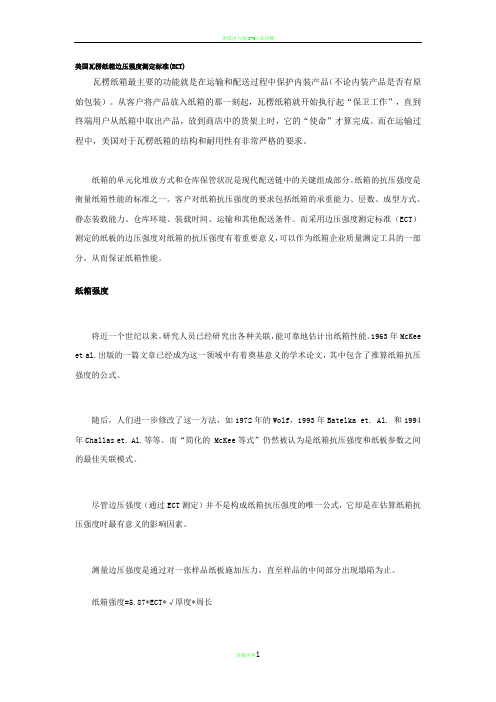
美国瓦楞纸箱边压强度测定标准(ECT)瓦楞纸箱最主要的功能就是在运输和配送过程中保护内装产品(不论内装产品是否有原始包装)。
从客户将产品放入纸箱的那一刻起,瓦楞纸箱就开始执行起“保卫工作”,直到终端用户从纸箱中取出产品,放到商店中的货架上时,它的“使命”才算完成。
而在运输过程中,美国对于瓦楞纸箱的结构和耐用性有非常严格的要求。
纸箱的单元化堆放方式和仓库保管状况是现代配送链中的关键组成部分。
纸箱的抗压强度是衡量纸箱性能的标准之一。
客户对纸箱抗压强度的要求包括纸箱的承重能力、层数、成型方式、静态装载能力、仓库环境、装载时间、运输和其他配送条件。
而采用边压强度测定标准(ECT)测定的纸板的边压强度对纸箱的抗压强度有着重要意义,可以作为纸箱企业质量测定工具的一部分,从而保证纸箱性能。
纸箱强度将近一个世纪以来,研究人员已经研究出各种关联,能可靠地估计出纸箱性能。
1963年McKee et al.出版的一篇文章已经成为这一领域中有着奠基意义的学术论文,其中包含了推算纸箱抗压强度的公式。
随后,人们进一步修改了这一方法,如1972年的Wolf,1993年Batelka et. Al. 和1994年Challas et. Al.等等。
而“简化的 McKee等式”仍然被认为是纸箱抗压强度和纸板参数之间的最佳关联模式。
尽管边压强度(通过ECT测定)并不是构成纸箱抗压强度的唯一公式,它却是在估算纸箱抗压强度时最有意义的影响因素。
测量边压强度是通过对一张样品纸板施加压力,直至样品的中间部分出现塌陷为止。
纸箱强度=5.87*ECT*√厚度*周长ECT与纸板材料的物理属性息息相关,涉及面纸和芯纸的强度,以及它们的粘合质量。
由此,就与同样具有测定纸板性能的其他方法——耐破强度区别开来。
而纸板的耐破强度基本上仅与面纸的质量有关。
每块瓦楞纸板都有具有耐戳穿强度和边压强度。
不过两种特点在纸箱强度中扮演着不同的角色。
ECT确定的是纸板结构的装载性能,而耐戳穿强度测定的则是戳穿纸板所需要的强度。
- 1、下载文档前请自行甄别文档内容的完整性,平台不提供额外的编辑、内容补充、找答案等附加服务。
- 2、"仅部分预览"的文档,不可在线预览部分如存在完整性等问题,可反馈申请退款(可完整预览的文档不适用该条件!)。
- 3、如文档侵犯您的权益,请联系客服反馈,我们会尽快为您处理(人工客服工作时间:9:00-18:30)。
Names of suppliers of testing equipment and materials for this method may be found on the Test Equipment Suppliers list in the bound 1set of TAPPI Test Methods, or may be available from the TAPPI Technical Operations Department.Approved by the Fiberboard Shipping Container Testing Committee of the Corrugated Containers DivisionTAPPIT 810 om-98SUGGESTED METHOD – 1966OFFICIAL TEST METHOD – 1980REVISED – 1985REVISED – 1992REVISED – 1998© 1998 TAPPIThe information and data contained in this document were preparedby a technical committee of the Association. The committee and theAssociation assume no liability or responsibility in connection with theuse of such information or data, including but not limited to anyliability or responsibility under patent, copyright, or trade secret laws.The user is responsible for determining that this document is the mostrecent edition published.Bursting strength of corrugated and solid fiberboard1.ScopeThis method describes the procedure for measuring the bursting strength of single wall and double wall corrugated and solid fiberboard. It is not designed to be used for the bursting strength of paper (TAPPI T 403 "Bursting Strength of Paper"), paperboard and linerboard (TAPPI T 807 "Bursting Strength of Paperboard and Linerboard"), or triple wall corrugated board.2.SignificanceThe bursting strength of combined board is primarily an indication of the character of the materials used in manufacturing a fiberboard box and has value in this respect. Bursting strength of combined board is an optional requirement of the various carrier regulations for shipping containers. The bursting strength of the component paperboard is an important control test in the paperboard mill since the conformity of the finished container is generally controlled by the bursting strength of the paperboard. Triple-wall corrugated board cannot be tested suitably by the bursting method. Testing of double-wall board is of questionable accuracy since it is rarely possible to get sufficiently simultaneous bursts of the multiple facings. The test is simple and rapid to execute, but it must be recognized that it is subject to serious errors if instrument, diaphragm, and gages are not properly maintained or if improper procedures are used (1, 2, 3).3.Apparatus3.1Bursting tester , consisting of the following:13.1.1Means for clamping the test specimen between two annular, plane surfaces having fine concentric tool marks to minimize slippage. The upper clamping platen (clamping ring) has a minimum diameter of 95.3 mm (3.75 in.),a minimum thickness of 9.53 mm (0.375 in.), and a circular opening of 31.50 ± 0.03 mm (1.240 ± 0.001 in.) diameter.The lower edge of the opening (side in contact with the board) has a 0.64 mm (0.025 in.) radius. The lower clamping surface (diaphragm plate) has a thickness of 5.56 ± 0.08 mm (0.219 ± 0.003 in.) with an opening 31.50 ± 0.03 mm (1.240± 0.001 in.) in diameter and an overall diameter at least as large as the upper clamping plate.. The upper edge of the opening (in contact with the board) has a 0.41 mm ± 0.1 mm (0.016 ± 0.004 in.) radius and the lower edge of the opening (in contact with the rubber diaphragm) has a radius of 3.1 ± 0.1 mm (0.122 ± 0.004 in.) to prevent cutting the rubber when pressure is applied. The upper clamping ring is connected to the clamping mechanism through a swivel joint tofacilitate an even clamping pressure. The openings in the two clamping plates are required to be concentric to within 0.13 mm (0.0051 in.) and their clamping faces flat and parallel (see T 807 Appendix A.1.1).3.1.2 A molded (disk-shaped) diaphragm requiring a pressure of not less than 160 kPa nor more than 210 kPa (not less than 23 psi nor more than 30 psi) to distend it to a height of 9.53 mm (0.375 in.) above the diaphragm plate (see T 807, Appendix A.1.2.)3.1.3Means of forcing liquid into the pressure chamber below the diaphragm at a steady rate of 170 ± 16 mL/min (0.045 ± 0.004 gal/min). This pressure shall be generated by a motor-driven piston forcing a liquid (glycerin) into the pressure chamber of the apparatus (see T 807, Appendix A.1.3).3.1.4 A Bourdon pressure gage of the maximum reading or the lazy hand type. The scale should have a radius of 47.6 mm (1.875 in.) with graduations extending over a minimum arc of 270° indicating bursting pressure in kPa or psi, with an accuracy of 0.5% of full scale, and have sufficient capacity so that all readings can be maintained in the middle half of the scale. In its operating position, have the gage inclined between horizontal and not over 30° from the horizontal. When more than one gage is mounted on a single apparatus, only the gage on which the measurement is being made is open to the hydraulic system so as not to reduce the rate of distention of the sample.3.1.5As an alternate to 3.1.4, a pressure transducer with suitable signal processing circuitry to display the maximum bursting pressure may be used provided it gives comparable results.3.1.6Electronic instruments are now available that automate and speed up the testing procedure. These instruments must maintain the critical elements of 3.1.1 through 3.1.3.NOTE 1:Care should be taken when comparing results between bourdon tube and electronic measuring systems. Differences in test results can arise due to differences in system expansibility and speed of data acquisition.3.1.7 Vernier caliper with micrometer gage to measure penetration of the upper clamping platen into the board.4.Calibration4.1Calibrate apparatus as per Instrument Manufacturers specifications.4.2Appendix A.1 of TAPPI T 807 describes a calibration procedure for one manufacturers apparatus.5.Sampling and test specimens5.1Solid fiberboard5.1.1From each test unit obtained in accordance with TAPPI T 400 "Sampling and Accepting a Single Lot of Paper, Paperboard, Containerboard, or Related Product," prepare five specimens at least 305 × 305 mm (12 × 12 in.). If the dimensions of each sheet of the test unit are too small, then use specimens no less than 102 mm (4 in.) wide and of sufficient length or number to permit a total of 20 bursts.5.2Corrugated board5.2.1From each test unit obtained in accordance with T 400, prepare five specimens at least 305 × 305 mm (12 × 12 in.). If size does not permit this, take specimens no less than 152 mm (6 in.) wide and of sufficient length or number to permit a total of 20 bursts.6.ConditioningCondition all specimens prior to testing and conduct tests in an atmosphere in accordance with TAPPIT 402 "Standard Conditioning and Testing Atmospheres for Paper, Board, Pulp Handsheets, and Related Products."7.Procedure7.1Solid fiberboard7.1.1Insert the specimen between the clamping ring and diaphragm plate, then apply a clamping pressure of 690 kPa (100 psi) either manually, pneumatically, or hydraulically and verify the pressure applied to the specimen. The specimen must not slip during the test.7.1.2Apply the bursting pressure by forcing the piston forward until the diaphragm ruptures the specimen. Record the maximum pressure registered.7.1.3Allot a minimum area of 102 x 102 mm (4 × 4 in.) for each burst to prevent the clamping areas from overlapping. Make an equal number of bursts from each side of the specimen. Arrange that no more than one burst fromeach side of the specimen falls in the same line of machine formation. Make no test on areas containing wrinkles, creases, or other obvious imperfections. Make a minimum of 6 bursts on each 305 × 305 mm (12 × 12 in.) specimen and a maximum of 10 bursts to determine the average bursting strength of the material tested.7.2Corrugated board7.2.1Insert the specimen between the clamping ring and the diaphragm plate. Apply a clamping pressure so that the top compression ring moves into the board to a depth as follows: "A" flute 2.08 ± 0.05 mm (0.082 ± 0.002 in.); "B" flute 0.81 ± 0.05 mm (0.032 ± 0.002 in.); "C" flute 1.62 ± 0.05 mm (0.062 ± 0.002 in.) and for Double Wall 3.05± 0.07 mm (0.12 ± 0.003 in.). The specimen must not slip during the test. Apply the bursting pressure by forcing the piston forward until the diaphragm ruptures the specimen. Record the maximum pressure registered.NOTE 2:On some testers equipped with a clamping wheel this corresponds to: "A" flute 3/4 turn; "B" flute 1/4 turn; "C" flute ½ turn and double wall 1 turn. Due to the surface and frictional characteristics of the board, the penetration depth to prevent slippage couldvary by +1/4 of a turn. If the tester is equipped with a hand wheel, pneumatic or hydraulic loading system adjust clamping pressureso that the sample will just slip between the clamping rings, measure the distance between the yoke and top clamping ring (see Fig.1), and adjust the pressure to get the specified penetration depth. There should be no slipping during the test, if slippage does occurincrease the penetration depth.7.2.2On corrugated board a minimum area of 152 × 152 mm (6 × 6 in.) is required for each burst. A22maximum of four bursts, two from each direction, is therefore made on each 930 cm (1 ft) specimen. A margin of at least 25 mm (1 in.) is left between the periphery of the clamping ring and the edge of the specimen. Locate the bursts so that not more than one burst from each direction is made in line with the same corrugation. Make a minimum of 20 bursts.NOTE 3:On testers with adjustable clamp pressure (pneumatic or hydraulic) the following alternative clamp procedure can be used.Determine the clamping force required to collapse the flutes of the test material. Reduce the clamp pressure by 35 kPa (5 psi) torun the burst tests.NOTE 4:Occasionally a "double pop" may occur on some corrugated materials. These results should be included in the report and labeled as double pops.8.Report2For each test unit report the average of the test determinations in kilopascals (or in lb/in. equivalent to kPa/6.89) to three significant figures.NOTE 5:For purposes of determining compliance with the optional carrier classification requirements, Uniform Freight Classification Rule41 and National Motor Freight Classification Item 222 specify a minimum bursting test rather than an average of the testdeterminations. These rules state, in effect, that only one burst (out of the six prescribed) is permitted to fall below the minimumtest required. Board failing to pass the foregoing will be accepted if, in a retest consisting of 24 bursts, not over 4 bursts fall belowthe minimum test required.9.Precision9.1Repeatability (within a laboratory) = 5.7%9.2Reproducibility (between laboratories) = 13.5%9.3The above values were obtained using test results, each an average of 20 determinations among 12 laboratories on 6 different corrugated combinations. The interlaboratory study was conducted in accordance with TAPPI T 1200 "Interlaboratory Evaluation of Test Methods Used with Paper and Board Products" by the Fibre Box Association Technical Committee, 1971-2.10.KeywordsCorrugated boards, Fiber boards, Burst strength.。
